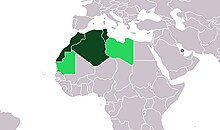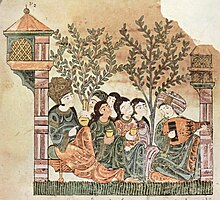Maghreb
Coordinates: 30 ° N , 5 ° E The Maghreb (also Maghrib ) is primarily understood to mean the North African territories of Tunisia , Algeria , Morocco and Western Sahara , which have a lot in common due to their geography and history. Even Libya and Mauritania are sometimes added to that. In general geographic terms, the name is North West Africa .
term
The word arabic المغرب al-maghrib , DMG al-maġrib 'the west' (literally "place where the sun goes down") derives from the verbغَرَبَ gharaba , DMG ġaraba 'go away, set (sun)', Tamazight ⵜⴰⵎⴰⵣⵖⴰ Tamazɣa , ab. The counterpart to the Maghreb is the Mashrek ( Egypt , Israel , Palestine , Jordan , Lebanon , Syria , Iraq ), Arabic المشرق al-Maschriq , DMG al-Mašriq 'the East, Orient' (literally “place where the sun rises”), derived from the verbشَرَقَ sharaqa , DMG šaraqa ' to rise (sun)'. It thus corresponds to the occidental Occident - Orient concept.
In Arabic, Maghreb is usually understood to mean Morocco, which is the westernmost Arab state and its own name is also al-Maghrib (short form of Arabic المملكة المغربية, DMG al-mamlaka al maġribiyya 'Kingdom of the Maghreb', literally "the Western Kingdom"). The internationally accepted importance of the Maghreb region is seen further and is primarily to be understood culturally.
In terms of natural space , Northwest Africa unspecifically includes the Atlantic coast from about the height of Cape Verde to Gibraltar and the Mediterranean coast to the Great Syrte including the hinterland. The area of the Maghreb is almost 6 million square kilometers. It forms the northern part of West Africa and the western part of North Africa, also two unspecific or widely defined terms. The former includes the francophone-dominated part of Africa, the latter that north of the Sahel zone (as opposed to sub-Saharan Africa ).
Similarities
The countries of the Maghreb have much in common with each other by their geographical location:
- four of the five countries are bordering the Mediterranean ;
- north of the Atlas Mountains there is a warm and humid climate; south of it is the extremely dry Sahara desert .
Prehistory and History
The cultures in the Maghreb were initially purely African . With the spread of agriculture , oriental influences came to Egypt and, as the cardial or imprint culture spread, also to the Maghreb. This was first under Phoenician influence in ancient times . Carthage , the largest and most powerful “ Punic ” city, is in Tunisia. After the Punic Wars , the entire region came under the Roman Empire . The area, mainly inhabited by Berbers , was largely Christianized by the influence of Augustine when it came under Arab influence with the spread of Islam in the 7th century; to this day most of them speak the autochthonous Berber languages . The centuries-long Ottoman influence that followed declined through European colonization in the 19th and 20th centuries. Today's demarcation of the states of the Maghreb is based partly on Ottoman, partly on European decisions.
After the Second World War, France wanted to bind the colonies even closer to itself politically. 1956 but gave France Morocco and Tunisia to independence . Morocco immediately began making claims on Mauritania and Western Sahara . When the French colonies were asked to vote in a referendum in 1958 , the majority of the population preferred a further connection to France to complete independence . In 1960, however, the French colonial empire was history ( decolonization of Africa ). The defeats in the war of independence in Algeria (1954–62) also diverted France from its colonialist policy. Algeria had the status of a colony until the victory of the Algerian Liberation Front ( FLN ) in 1962.
In the 1980s there were several so-called bread riots in the Maghreb countries .
See also: History of Algeria , History of Tunisia, and History of Morocco , Arab Spring
The Arab Maghreb Union
The states of Algeria , Mauritania , Morocco (only from a Moroccan perspective, including Western Sahara ), Libya and Tunisia founded the multinational Union of the Arab Maghreb in 1989.
languages
In the Maghreb, Maghrebian Arabic is mainly spoken. Furthermore, Berber languages are represented, in Algeria and Morocco also as official languages . French is of great importance as a commercial, educational and cultural language in the Maghreb states.
economy
Algeria is the economically strongest country, as the following comparative figures of the gross domestic product show (figures in millions of US dollars).
| International Monetary Fund figures (2013) | World Bank figures (2013) | Figures from the CIA World Factbook (2013) | ||||||||||||||||||||||||||||||||||||||||||||||||||||||
|
|
|
Situation after 2010
There has been strong population growth in all North African countries in the last few decades . In Morocco, Tunisia and Libya 30 percent of the population are under 15 years old, in Algeria 26 percent and in Mauritania 40 percent (see FAO Food Price Index ).
Tunisia
The self-immolation of a desperate young greengrocer sparked unrest in Tunisia. The reason for his act was that the authorities forbade him to trade in vegetables, thereby depriving him and his family of their livelihoods.
The unrest began on December 13, 2010 and spread to the whole country until the Tunisian President fled into exile on January 14, 2011 after 23 years in government. Protests began a short time later in other Arab countries (see also Revolution in Egypt 2011 ).
Since then, the Maghreb and other countries in the Arab world have been the focus of the media around the world.
Algeria
On around January 5, 2011, riots began in Algeria . There (as in other countries) people protested against massive increases in basic food prices . The riots sparked spontaneously from individual events. According to the International Monetary Fund ( IMF ), 75 percent of Algerians are under 30 years of age, and more than 20 percent of them are unemployed.
Libya
After isolated larger protests, there were demonstrations in several large cities on February 15, 2011, which subsequently expanded into a nationwide uprising, which ended with the overthrow of the government of Muammar-al-Gaddafi and his death.
literature
- Werner Herzog: The Maghreb: Morocco, Algeria, Tunisia. CH Beck, Munich 1990, ISBN 978-3-406-33180-0 .
Web links
- Database of indexed literature on the social, political and economic situation in Maghreb
- Maghreb news
- Union du Maghreb Arabe
- Maghreb Arab Online
Individual evidence
- ↑ See Hans Wehr: Arabic Dictionary , Wiesbaden 1968, p. 426.
- ↑ See Middle East .
- ↑ Babak Khalatbari: European Near and Middle East Policy. Squaring the circle? In: Hans-Georg Ehrhart, Sabine Jaberg, Bernhard Rinke, Jörg Waldmann: The European Union in the 21st Century: Theory and Practice of European Foreign, Security and Peace Policy. Festschrift for Reinhard Meyers. Springer-Verlag, 2008, ISBN 978-353190576-1 , Chapter 1.3 Geographical Definitions: Maghreb , pp. 175–176 (full article, pp. 174–187; limited preview in Google book search).
- ↑ a b Region in excitement: powder keg North Africa. ( Memento from January 20, 2011 in the Internet Archive ) on: rp-online.de January 17, 2011.
- ↑ Several deaths in protests. In: the daily newspaper . January 9, 2011, accessed January 12, 2011 .
- ↑ Over 20 dead in unrest in Tunisia. In: ORF . January 10, 2011, accessed January 12, 2011 .
- ^ Riots in Algeria: Hundreds injured and three dead in protests. In: stern.de. January 9, 2011.


